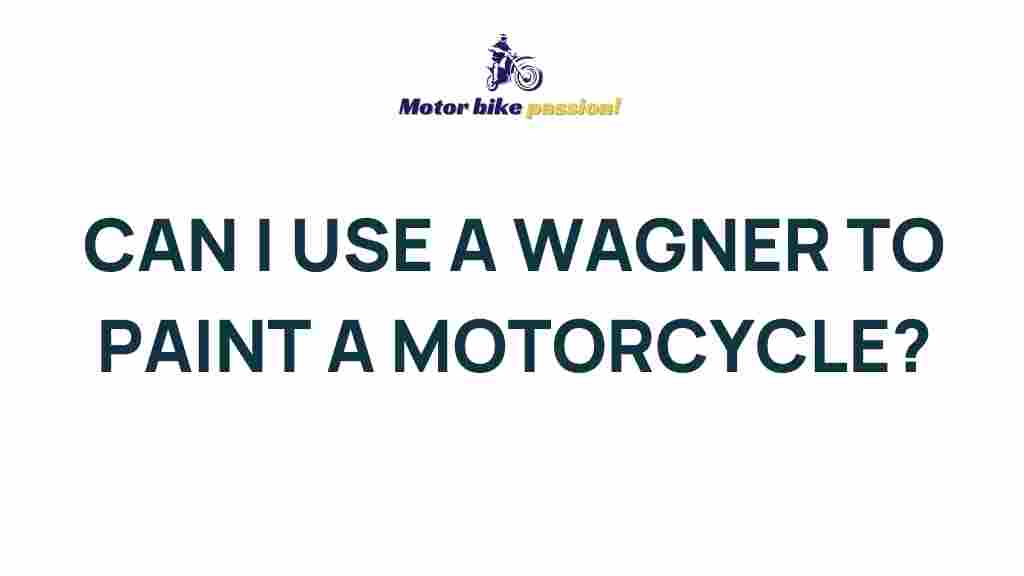Unleashing the Potential of Wagner Paint Sprayers: Transforming Your Motorcycle with Precision
Motorcycle enthusiasts often seek unique ways to express their personality and style through customization. One of the most effective methods to achieve a personalized look is through DIY painting. With the right tools, particularly a Wagner paint sprayer, transforming your motorcycle can be both an exciting and rewarding project. In this article, we will explore how to utilize a Wagner paint sprayer for motorcycle customization to achieve a professional finish that showcases your creativity.
Why Choose a Wagner Paint Sprayer?
Wagner paint sprayers are known for their efficiency and ease of use, making them a top choice for both DIY enthusiasts and professionals. Here are some reasons to consider using a Wagner paint sprayer for your motorcycle customization project:
- Smooth Finish: Wagner sprayers deliver an even coat, minimizing the risk of streaks or uneven patches.
- Time-Saving: Sprayers cover large areas quickly, reducing the time spent on painting.
- Versatility: Ideal for various surfaces and materials, including metal, plastic, and more.
- Adjustable Settings: Many models allow you to adjust the spray pattern and flow for precision control.
Preparing for Your Motorcycle Customization Project
Before diving into the painting process with your Wagner paint sprayer, proper preparation is key to achieving a professional finish. Here’s a step-by-step guide to get you started:
1. Gather Your Materials
Make sure you have all the necessary materials before you begin:
- Wagner Paint Sprayer: Choose the model that best suits your needs.
- Paint: Select high-quality paint suitable for motorcycles.
- Primer: Essential for ensuring paint adhesion.
- Sandpaper: Various grits for surface preparation.
- Masking Tape: To protect areas you don’t want to paint.
- Drop Cloths: For protecting your workspace.
- Safety Gear: Gloves, goggles, and a mask to protect against fumes.
2. Prepare Your Motorcycle
To ensure a smooth painting process, follow these preparation steps:
- Clean the Surface: Thoroughly wash your motorcycle to remove dirt and grease.
- Sand the Surface: Use sandpaper to scuff the existing paint and create a better surface for the primer.
- Mask Off Areas: Use masking tape to cover any parts of the motorcycle you do not want to paint.
3. Apply Primer
Applying a primer is crucial for a long-lasting finish. Here’s how to do it:
- Use your Wagner paint sprayer to apply an even coat of primer to the motorcycle.
- Allow it to dry according to the manufacturer’s instructions.
- Sand lightly after drying for optimal paint adhesion.
Painting Your Motorcycle with a Wagner Paint Sprayer
Now that your motorcycle is prepped and primed, it’s time to unleash your creativity. Follow these steps to paint your motorcycle:
1. Select Your Paint Color
Choose a color that reflects your style. Consider using multiple colors or patterns for a more intricate design.
2. Set Up Your Wagner Paint Sprayer
Follow the manufacturer’s guidance to set up your Wagner paint sprayer:
- Fill the sprayer with your chosen paint.
- Adjust the nozzle and spray pattern according to your project needs.
- Test the sprayer on a scrap piece of material to ensure the spray pattern is correct.
3. Begin Spraying
Start by applying the paint in thin, even layers:
- Hold the sprayer approximately 6-12 inches from the surface.
- Use smooth, sweeping motions to cover the motorcycle.
- Allow each layer to dry before applying the next, following the manufacturer’s drying times.
4. Add Additional Coats
Depending on the color and finish you desire, you may need to apply multiple coats:
- Wait for the first coat to dry completely before applying the next.
- Assess the coverage and apply additional coats as necessary.
5. Finishing Touches
Once you have achieved the desired color and finish:
- Apply a clear coat for added protection and shine.
- Remove any masking tape carefully to reveal clean lines.
- Inspect for any imperfections and touch up as needed.
Troubleshooting Common Issues
Even with the best preparations, you may encounter some common issues during your motorcycle painting project. Here are some troubleshooting tips:
1. Drips and Runs
If you notice drips or runs in your paint, it may be due to:
- Applying too thick of a coat. Solution: Use thinner coats and allow for adequate drying time between layers.
- Holding the sprayer too close to the surface. Solution: Maintain the recommended distance and keep a steady hand.
2. Uneven Coverage
If your motorcycle has areas with uneven paint coverage:
- Check your sprayer settings; adjust the flow and pattern as needed.
- Ensure you are moving the sprayer consistently and at the right speed.
3. Paint Peeling or Chipping
To prevent peeling or chipping, ensure:
- Proper surface preparation (cleaning and sanding) was conducted.
- Primer was used and allowed to dry completely before painting.
Conclusion
Transforming your motorcycle through DIY painting can be a fulfilling experience, especially when using a Wagner paint sprayer. With the right preparation, techniques, and a little creativity, you can achieve a professional finish that reflects your unique style. Whether you’re customizing your bike for personal enjoyment or to stand out on the road, a Wagner paint sprayer is an invaluable tool in your arsenal.
Remember to take your time, follow the instructions carefully, and enjoy the process. For more tips on creative projects and motorcycle customization, check out this helpful guide. If you’re interested in purchasing a Wagner paint sprayer, visit their official site for more information on models and specifications here.
This article is in the category Maintenance Tips and created by MotorBikePassion Team
